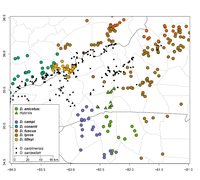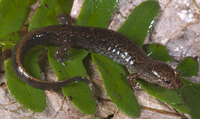Taxonomy
Class: AmphibiaOrder: CaudataFamily: PlethodontidaeSubfamily: PlethodontinaeAuthor: Pyron and Beamer, 2023
Taxonomic Comments: The Spotted Dusky Salamander (Desmognathus conanti ) and Northern Dusky Salamander (D. fuscus ) as traditionally recognized by herpetologists have a long and complex taxonomic history, with the former originally described as a subspecies of D. fuscus . It was treated as such until genetic studies revealed that it is not closely related to the latter (Beamer and Lamb 2008; Kozak et al. 2005). According to the latest systematic treatment of these species by Pyron and Beamer (2023a) At least 10 other currently recognized species of Desmognathus were either described from populations previously considered to be D. fuscus , described as or later considered to be subspecies of D. fuscus , or later considered to be synonyms of D. fuscus before ultimately being recognized as distinct species. The latest molecular analyses have also revealed extensive cryptic diversity within both D. conanti and D. fuscus as currently conceived, with these two species constituting a polyphyletic assemblages of 13 distinct mitochondrial lineages and perhaps as many as 11 candidate species. Pyron and Beamer (2023a) provide a very comprehensive review of the taxonomic history of this group. Desmognathus species and lineages. Gene exchange has occurred between both phylogenetically sister and geographically adjacent populations, as well as between distantly related and spatially separated groups. In summary, both D. conanti and D. fuscus are now each known to represent polyphyletic assemblages of multiple, geographically well-defined candidate species that are phylogenetically interdigitated with other recognized species. The candidate species include a “mountain dusky”phenotype with smaller, gracile bodies and round tails, a lowland “dusky” type with more robust, larger bodies and keeled tails, and a smaller lowland “dusky” form often associated with ravine streams and adjacent swamps, with slenderer bodies and less heavily-keeled tails.D. conanti and D. fuscus, the authors recognized six additional species based on genetic, geographic, and morphological evidence. They also redefined D. conanti and D. fuscus . The new species are D. anicetus , D. bairdi , D. campi , D. catahoula , D. lycos and D. tilleyi . Among the newly described species, all but D. catahoula occur in North Carolina. Species Comments:
Identification
Description: As described by Pyron and Beamer (2023a), this is a small, slender, high-elevation species that has the general appearance of a mountain dusky salamander. Specimens typically have a brightly colored or bold dorsal pattern that consists of paired larval spots that develop into blotches with age. The blotches can be red, orange, yellow, brown, dark brown or black on melanistic specimens, and are usually margined with black along the outer edges. They extend a short distance onto the tail before transitioning into a continuous dorsal stripe that often extends to near the tail tip. The lateral ground color can vary from light yellowish brown to black and is overlain with extensive whitish flecking. Pyron and Beamer (2023a) note that the color and patterning varies extensively within and among populations. This species closely resembles D. carolinensis but the two species occur parapatrically. Based on the known distributions of the two species (see range map above), the site of collection should be sufficient to identify these species in the field.Online Photos: Google iNaturalist AmphibiaWeb Account
Distribution in North Carolina
Distribution Comments: This is a narrow endemic to the southern Appalachians, with the known populations centered on the southern portion of the Bald Mountains of Tennessee (southeastern Sevier County and southwestern Cocke County) and North Carolina (extreme northwestern Madison County and northeastern Haywood County) Specimens have been documented from Lemon Gap to the Pigeon River, and in the adjacent foothills of the Great Smoky Mountains (Pyron and Beamer, 2023a) at elevations ranging from around 400-1300 m (1312 – 4265’).Distribution Reference: Pyron and Beamer, 2023aCounty Map: Clicking on a county returns the records for the species in that county.
GBIF Global Distribution
Key Habitat Requirements
Habitat: This species is found is mountain seepages and headwater and low-order streams, as well as in adjoining areas of forests.
Life History and Autecology
General Ecology
Adverse Environmental Impacts
Status in North Carolina
NHP State Rank: [S1S2]Global Rank: GNRStatus in North Carolina: [SR]Status Comments: This is a very narrow endemic to the southern Appalachians, with the known populations centered on the southern portion of the Bald Mountains of Tennessee (southeastern Sevier County and southwestern Cocke County) and North Carolina (extreme northwestern Madison County and northeastern Haywood County) Specimens have been documented from Lemon Gap to the Pigeon River, and in the adjacent foothills of the Great Smoky Mountains (Pyron and Beamer, 2023a) at elevations ranging from around 400-1300 m (1312 – 4265’). Local populations use seepages, streams, and streamside habitats and are most common in headwater and lower-order streams where they can reach high local densities. Most local populations in North Carolina are in national forest lands and receive a significant level of protection.

 »
»


 »
»
